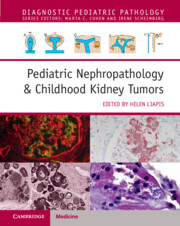Book contents
- Pediatric Nephropathology & Childhood Kidney Tumors
- Diagnostic Pediatric Pathology
- Pediatric Nephropathology & Childhood Kidney Tumors
- Copyright page
- Dedication
- Contents
- Contributors
- Preface
- Section 1 Normal and Abnormal Human Kidney Development
- Section 2 Glomerular Diseases
- Section 3 Tubulointerstitial Diseases
- Section 4 Vascular Diseases
- Section 5 Infectious Diseases
- Section 6 Cystic Diseases
- Chapter 13 Autosomal Dominant Polycystic Kidney Disease and Autosomal Recessive Polycystic Kidney Disease
- Chapter 14 Tuberous Sclerosis Complex
- Chapter 15 Glomerulocystic Kidney (GCK) and GCK Disease (GCKD)
- Chapter 16 Nephronophthisis Complex
- Section 7 Solid Tumors of the Kidney
- Section 8 Transplant Pathology of the Kidney
- Index
- References
Chapter 15 - Glomerulocystic Kidney (GCK) and GCK Disease (GCKD)
from Section 6 - Cystic Diseases
Published online by Cambridge University Press: 10 August 2023
- Pediatric Nephropathology & Childhood Kidney Tumors
- Diagnostic Pediatric Pathology
- Pediatric Nephropathology & Childhood Kidney Tumors
- Copyright page
- Dedication
- Contents
- Contributors
- Preface
- Section 1 Normal and Abnormal Human Kidney Development
- Section 2 Glomerular Diseases
- Section 3 Tubulointerstitial Diseases
- Section 4 Vascular Diseases
- Section 5 Infectious Diseases
- Section 6 Cystic Diseases
- Chapter 13 Autosomal Dominant Polycystic Kidney Disease and Autosomal Recessive Polycystic Kidney Disease
- Chapter 14 Tuberous Sclerosis Complex
- Chapter 15 Glomerulocystic Kidney (GCK) and GCK Disease (GCKD)
- Chapter 16 Nephronophthisis Complex
- Section 7 Solid Tumors of the Kidney
- Section 8 Transplant Pathology of the Kidney
- Index
- References
Summary
GCK and GCKD are terms used for kidney phenotypes characterized by glomerular cysts, defined as ≥2–3× dilatation of the Bowman’s space involving >5% of glomeruli in a given kidney section. GCK is a phenotype found in known hereditary cystic kidney diseases such as ADPKD, ARPKD and tuberous sclerosis, as well as numerous syndromes with multiple organ anomalies including renal dysplasia. Isolated GCK has also been described. Those cases with a specific genetic mutation/s are referred to as GCKD; included are subcategories within the nephronophthisis (ADTKD-UROM) spectrum and other ciliopathies such as heterozygous loss-of-function of SEC61A1 gene, also an autosomal dominant disease. The term GCKD is reserved for those cases presenting with GCK that do not fit in the already accepted classifications such as autosomal dominant tubulointerstitial diseases (ADTKD) (see Chapter 16). The pathogenesis of glomerular cysts remains speculative and includes developmental (glomerular patterning) gene defects and obstruction of the junction between the proximal tubule and the developing glomerulus. However, obstruction at this junction has yet to be proven in humans. The prognosis for kidney function is not good but kidney transplantation is reported with good results. Gene therapy/stem cell approaches are under investigation for premature macula densa degeneration which is included in a subset of GCK-related disorders (Bardet–Biedl syndrome/retinitis pigmentosa).
Keywords
- Type
- Chapter
- Information
- Pediatric Nephropathology & Childhood Kidney Tumors , pp. 283 - 289Publisher: Cambridge University PressPrint publication year: 2023

